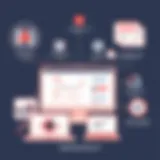Comprehensive Guide to Note Taking Software for Mac


Intro
In today’s fast-paced digital environment, the ability to capture and organize information efficiently is crucial. For Mac users, selecting the right note-taking software can significantly enhance productivity and streamline workflows. This article delves into various software options available, addressing features, user experiences, and best practices.
The right choice of software not only aids in capturing notes but also assists in organizing thoughts, managing projects, and collaborating with peers. This is especially important for business professionals, procurement managers, and IT specialists who seek to optimize their organizational processes.
With numerous products in the market, understanding key features and unique selling propositions becomes essential in making a well-informed decision.
Key Features
Overview of Features
When considering note-taking software for Mac, users should focus on several essential features that can enhance the note-taking experience. Key functionalities to look for include:
- Cross-Platform Compatibility: The ability to access notes across multiple devices, ensuring information is always available when needed.
- Collaboration Tools: Features that allow for real-time collaboration, making it easy to work with team members on shared projects.
- Organization Systems: Options for organizing notes through tags, folders or categories, which assist in finding information quickly.
- Search Functionality: A powerful search feature to locate specific notes and information efficiently.
- Integration with Other Apps: The option to integrate with productivity tools like calendars, to-do lists, and cloud storage solutions can significantly enhance workflow.
These features influence how well the software can meet the user’s needs, especially in professional settings where time and efficiency are paramount.
Unique Selling Propositions
Different note-taking software options for Mac possess various unique selling propositions that set them apart from competitors. For instance:
- Notability is known for its intuitive interface and exceptional handwriting recognition, making it ideal for those who prefer writing by hand.
- Evernote shines in its organizational capabilities, offering a robust tagging and search system, which is particularly useful for research and large note collections.
Each software comes with its unique blend of features and distinct advantages, thus addressing different user needs. Understanding these nuances helps in making better choices that align with specific organizational objectives.
Pricing Models
Different Pricing Tiers
The cost of note-taking software varies significantly, often based on features and functionalities. Notable pricing tiers include:
- Free Versions: Many tools offer basic functionality at no cost, allowing users to test the waters before investing.
- Subscription Plans: Applications like Notability or Evernote typically provide enhanced features for a monthly or annual fee, often justified by advanced collaboration or integration capabilities.
- One-Time Purchases: Alternatives like Ulyssees may have a higher upfront cost but do not involve ongoing subscription fees, making it appealing to certain users.
ROI and Cost-Benefit Analysis
Evaluating the return on investment (ROI) of note-taking software is crucial, especially for business decision-makers. Considerations for a cost-benefit analysis may include:
- Increased Team Productivity: Invest in software that promotes collaboration can lead to improved teamwork.
- Time Savings: Tools that enable quick searches or information retrieval can save hours over time.
- Reduced Training Costs: Intuitive software that is easy to use reduces the need for extensive training.
Assessing these factors can lead to smarter purchasing choices, aligning software capabilities with organizational goals.
Intro to Note Taking Software
Note taking software serves as a critical tool for both personal and professional settings. Its importance lies in the ability to capture, organize, and manage information efficiently. For users, especially those on Mac platforms, these applications are more than just a digital replacement for pen and paper; they embody an integrated solution for knowledge management, collaboration, and workflow enhancement.
In today’s fast-paced environment, the demand for streamlined communication and effective information archiving has grown significantly. Note taking software provides a systematic approach to address this need. It simplifies the process of storing thoughts, meeting notes, and project details. It enables users to categorize information, making retrieval straightforward when required.
Understanding Note Taking Software
Note taking software can encompass a variety of functionalities. From simple text editors to advanced organizational systems, the options vary. At its core, note taking software refers to any digital tool that allows users to write, edit, and save notes. This can include rich text formatting, multimedia support, and even task management features.
Many software options boast capabilities such as tagging, searching, and syncing across devices. The blend of these features can transform how users interact with their notes. Choosing the right application often depends on individual needs, like whether one prioritizes collaboration, integration, or user interface.
Importance for Mac Users
For Mac users specifically, note taking software can be optimized to leverage the unique capabilities of Apple’s ecosystem. Features such as iCloud integration enhance seamless access across devices. Users benefit from native support for touchpads, gestures, and other ergonomic considerations of Mac hardware.
Additionally, Mac users often value aesthetics in software design. A clean and intuitive user interface can improve productivity. Furthermore, applications like Bear, Evernote, and Apple Notes offer not just functionality, but also a pleasant experience that aligns with the Mac ethos.
These factors underscore the necessity of selecting the right note taking software tailored for the Mac user experience. With the right tools, users can manage their information flow more effectively, fostering both creativity and productivity in their personal and professional lives.
Key Features of Note Taking Software


The selection of note-taking software often hinges on specific characteristics that cater to user needs. These key features not only facilitate efficient note organization but also enhance overall user experience. Understanding these elements is vital for any Mac user navigating the diverse options available today. In this section, we will delve into essential aspects of note-taking software that can significantly affect how users interact with their notes and optimize their workflows.
User Interface and Experience
A well-designed user interface (UI) is critical in making software intuitive and easy to navigate. For note-taking software, the layout should enable quick access to tools and notes without unnecessary clutter. Clean design with a logical structure can save time and enhance productivity.
An efficient interface often includes:
- Customizable themes: Users may prefer different visual settings. A choice between a light and dark mode can reduce eye strain during prolonged sessions.
- Intuitive navigation: Features such as drag and drop, horizontal menus, and quick access bars improve usability.
- Search functionality: Powerful search capabilities allow users to locate specific notes swiftly, which is essential for effective information retrieval.
An effective user experience encompasses these UI elements, ultimately influencing note-taking effectiveness. Good software strikes a balance between rich features and simplicity of use.
Organizational Tools
Effective organization within note-taking software plays a significant role in managing a large volume of information. Tools that facilitate organization should enable users to categorize notes efficiently, ensuring that retrieval is never a cumbersome process.
Key organizational tools include:
- Tags and labels: These enable users to sort and filter notes based on various themes or projects. This method enhances discoverability and contextual groupings.
- Notebooks or folders: Visual hierarchies allow users to segment notes into manageable sections, each pertinent to specific subjects or topics.
- Searchable text: Notes that can be indexed and searched quickly alleviate the frustration of sifting through materials manually.
Such features help users maintain a structured approach to their note collection, leading to improved productivity.
Integration with Other Applications
In today’s interconnected digital landscape, note-taking software must seamlessly integrate with other applications and tools. This capability can drastically improve workflows by reducing the time spent switching between different platforms.
Noteworthy integrations often include:
- Cloud storage services, such as Dropbox or Google Drive, which allow for easy backup and syncing across devices.
- Productivity suites, like Microsoft Office or Google Workspace, where notes can be easily shared and utilized within documents or presentations.
- Task management tools, allowing users to convert notes into actionable tasks without additional effort.
Integration capabilities not only streamline the user experience but also make note-taking software a central hub for productivity.
Collaboration Features
In an increasingly collaborative work environment, note-taking software must also include features that accommodate teamwork. Software that supports collaboration fosters communication and enhances the collective intelligence of a team.
Common collaboration features might consist of:
- Real-time editing: Users can edit and update notes simultaneously, making it easier to brainstorm and share ideas.
- Commenting: Ability for team members to leave feedback or ask questions directly on the notes facilitates discussions and refines ideas.
- Shared notebooks: Allows teams to collectively curate information and resources, keeping everyone on the same page.
Implementing these collaboration features not only fosters a sense of community among users but also boosts productivity through shared efforts.
As we reflect on these key features, it becomes clear that they are integral to the function and utility of note-taking software. A combination of user-friendly design, robust organizational tools, integration capabilities, and collaborative functions ensures that users can optimize their note-taking practices effectively.
Popular Note Taking Software Options for Mac
Selecting appropriate note taking software is crucial for enhancing productivity, especially for Mac users. This section analyzes popular software options available, which can significantly impact organizational efficiency. For professionals, the choice of software affects collaboration, data management, and overall workflow.
Software Overview
Various note taking solutions cater to different needs. Whether for personal use or team collaboration, understanding each option helps users make informed decisions. Key features offered by these applications include organizational tools, interface design, and integration capabilities with other software environments. Evaluating the software landscape reveals how these tools serve distinct purposes and fit various work styles.
Comparative Analysis of Key Software
Evernote
Evernote is widely recognized for its versatility in note taking. Its primary contribution lies in note organization and easy retrieval. Users appreciate Evernote's powerful search functionality, which allows for quick access to notes that may be scattered across different notebooks. An important characteristic is its sync capability across devices, making it reliable for users who work on the go. However, Evernote may require a learning period, as new users sometimes find its extensive features overwhelming. A unique feature is the ability to capture web articles for later reference, streamlining the research process. Nonetheless, some users report issues with export limitations when wanting to transfer data.
Notion
Notion's approach to note taking is more that of an all-in-one workspace. It combines note taking with database management, allowing users to link notes directly to other organizational tools within the app. Its flexibility is a key characteristic, making it suitable for diverse use cases from project planning to personal journaling. Notion also stands out with its collaborative features, enabling teams to work on notes collectively. However, it can become complex for users who prefer simplicity. The fluidity of creating custom templates is a noteworthy bonus, though navigation can be difficult initially.
Microsoft OneNote


Microsoft OneNote resembles a digital notebook where users can freely place text and images on the page. This characteristic appeals to those who prefer a free-form note taking experience. A major advantage is its integration with the Microsoft Office suite, making it a natural choice for existing Office users. OneNote provides excellent organizational tools through notebook sections. Still, performance can be inconsistent on some systems, which may deter users looking for a seamless experience. Its unique tagging feature allows easy categorization of notes, adding to its organizational strength.
Bear
Apple Notes
Apple Notes stands out for its simplicity and integration into the Apple ecosystem. It provides straightforward note taking functionalities without overwhelming users with advanced tools. Its strength lies in its ease of access across all Apple devices, making it a natural default for many users. A unique feature is the ability to scan documents directly within the app. Nonetheless, it falls short in terms of organizational features when compared to other software options. Its limited formatting options may not meet the needs of users looking for more robust text editing capabilities.
Selecting the best note taking software depends on individual and organizational needs. Each option offers unique strengths that can enhance productivity in distinct ways.
Pricing Models and Cost Analysis
Pricing models and cost analysis play a crucial role in the decision-making process for choosing note taking software on Mac. Understanding the different pricing structures helps users to evaluate what they are getting in return for their investment. This section will cover the essential components of pricing models, including the pros and cons of free versus paid options and the overall value proposition of more expensive software solutions.
Free vs. Paid Options
Many note taking applications offer both free and paid versions, presenting a dilemma for users on which option to choose. Free options may suffice for casual users, especially those who take basic notes. However, organizations and professionals often require more advanced features such as cloud storage, collaboration, and offline access, which are typically only available in paid versions.
Free Options
- Usually have limited features, such as storage space and organizational tools
- Good for simple note-taking needs
- May collect user data or show advertisements
Paid Options
- Offer complete functionalities, including integrations with other software
- Provide customer support and frequent updates
- Often include enhanced security features, crucial for sensitive information
Evaluating these factors allows users to determine if the cost of a paid option is justified for their specific needs and usage.
Value Proposition of Paid Software
Paid note taking software often presents a compelling value proposition that can optimize productivity and efficiency within teams or for individual users. The benefits of opting for paid versions can be substantial.
- Rich Feature Sets: Paid options usually come equipped with advanced functionalities like task management integration, multimedia note options, and extensive organizational tools. This can greatly enhance note-taking practices.
- High-Level Security: Businesses that manage sensitive data will find that many paid software options offer robust security protocols protecting user data from breaches. This is a critical factor when making a purchase decision.
- Customer Support: Access to dedicated customer support is often limited or non-existent in free versions. Paid software usually provides timely assistance to resolve issues, making the user experience smoother.
- No Advertisements: Without ads, users can enjoy a more focused and undistracted work environment. This is especially beneficial for lengthy or in-depth note-taking sessions.
In summary, while the temptations of free options are understandable, evaluating the specific needs of your organization or personal use will clarify whether investing in a paid solution is prudent. Understanding the pricing models and their implications ensures better decision making and, ultimately, better productivity, making these considerations vital for any serious user of note taking software.
User Experience Considerations
User experience is a crucial factor when selecting note taking software for Mac users. The way a user interacts with the software directly impacts efficiency, satisfaction, and overall productivity. Devices are meant to assist in organizing thoughts and information, and a smooth user experience ensures that these goals are met. Elements such as accessibility features, customization options, and the learning curve play significant roles in how effectively one can utilize the software.
Accessibility Features
Accessibility features facilitate easier use of note taking software for individuals with diverse needs. Inclusion of voice recognition, screen readers, and keyboard shortcuts enhances the usability for all users. For example, applications like Microsoft OneNote provide support for screen readers, making content accessible to visually impaired users. In addition, adjustable text sizes and customizable color schemes cater to users with different visual preferences. By prioritizing accessibility, software developers can ensure that their tools are functional for a broader audience, allowing all users to benefit from their capabilities.
Customization Options
Learning Curve for New Users
The learning curve is an essential consideration for new users adopting note taking software. Software with intuitive interfaces can facilitate quick adaptation; however, more complex systems may require extensive training. For instance, Notion, while powerful, can overwhelm new users with its myriad of features. Conversely, simpler programs like Apple Notes may be more approachable for users who prefer straightforward functions. Offering tutorials and support documentation can significantly aid users in overcoming initial hurdles. Thus, understanding the software's learning curve is pivotal in ensuring users can effectively integrate these tools into their productivity regimen.
Best Practices for Utilizing Note Taking Software
Note taking software has become an essential tool for many users, especially those on the Mac platform. Embracing best practices in utilizing this software ensures that users maximize their productivity and efficiency. Effective note-taking practices enable users to organize thoughts clearly, retrieve information quickly, and improve overall workflow. These best practices not only streamline the process of taking and managing notes but also enhance the utility of the software itself.
Effective Note Structuring Techniques
Structuring notes effectively is foundational for anyone looking to capture and review information efficiently. Users should consider the following techniques:
- Hierarchical Organization: Arrange notes in a hierarchy. Start with broad topics and branch out into subtopics. This mimics the way information is naturally organized.
- Consistent Formatting: Use consistent fonts, bullet points, and headings. This makes scanning notes easier and helps maintain clarity.
- Tags and Keywords: Utilize tags for key themes or subjects. This aids in quick searches and retrieval of related information.
Taking time to establish a clear structure can greatly influence how well the notes serve the intended purpose. For example, in a meeting scenario, organizing notes by agenda items allows for easier reference during discussions.


Implementing a Consistent Workflow
A consistent workflow is key to integrating note-taking software into daily routines. An established process ensures that notes are not only taken but also reviewed and utilized effectively. Here are crucial elements to consider:
- Schedule Regular Reviews: Set aside time regularly to review notes. This reinforces memory retention and helps identify areas needing further reflection or action.
- Integrate with Daily Tasks: Align note-taking with day-to-day activities. For example, if using project management tools such as Asana or Trello, linking notes related to each task can improve organization.
- Utilize Automated Features: Explore automation capabilities within the software, such as reminders for follow-ups based on notes taken. This adds a level of efficiency that manual processes may lack.
Effective note management hinges on a consistent workflow, allowing users to turn recorded thoughts into actionable insights.
By implementing these best practices, users can ensure that their note-taking experience is productive and aligns with their needs. The advantages of efficient note-taking lead to better retention, improved organization, and overall more effective communication.
Case Studies of Successful Implementation
Understanding how organizations successfully implement note taking software is essential for gaining insight into effective strategies and practices. Case studies provide real-world examples that illustrate the challenges and solutions encountered during the process. By analyzing these scenarios, potential users can recognize the benefits, concerns, and specific features that made a notable impact on productivity.
Business Use Case Scenarios
In various sectors, note taking software has proven to enhance efficiency and encourage collaborative efforts. For instance, a tech startup named Innovatech utilized Notion to streamline its project management. The intuitive layout allowed team members to document progress, share insights, and note action items in a central location. This not only improved communication but also minimized the chances of misinterpretation—a frequent hurdle in fast-paced environments.
Another example includes a university that adopted Microsoft OneNote in their administration. Faculty members and staff utilized this software to gather meeting notes, track academic schedules, and maintain records in a structured manner. The integration with other Microsoft services provided seamless data flow and minimized redundancy. Thus, this facilitated more efficient decision-making and reduced time spent on administrative tasks.
Lessons Learned from Implementation Efforts
Through the examination of various implementations, several key lessons appear:
- Customization is Key: Each organization has its needs. Tailoring the note-taking process can significantly affect adoption rates among users. Not all templates are applicable, so adaptability becomes crucial.
- Training and Support: Effective training programs can illuminate the software's capabilities. Invest in workshops or online tutorials to boost user confidence. A solid knowledge base encourages consistent utilization of the tool.
- Emphasize Collaborative Features: Highlight the collaborative aspects from the onset. Features that promote team engagement can enhance the overall experience, making software more appealing. For example, centralized document editing and sharing foster teamwork.
"The move to digital is transformative, but the transition requires strategic foresight. Understanding user expectations can help organizations select the right tools for their teams."
By evaluating these lessons and strategies, organizations can refine their approach to adopting note taking software, ensuring a smoother transition that meets their operational demands. This analysis sets the stage for informed decision-making moving forward.
Future Trends in Note Taking Software
The landscape of note taking software for Mac is evolving constantly. This evolution is shaped by both technological advancements and changing user needs. Understanding these future trends is crucial for organizations looking to leverage effective tools for information management. Key trends can greatly enhance productivity, foster efficiency, and provide depth in the note taking process.
Developing Technologies
Recent developments in technology are influencing how note taking software functions. Machine learning and artificial intelligence play a significant role. These technologies allow for smart categorization and retrieval of notes. For instance, software like Evernote implements AI to analyze user input and suggest tags automatically. Additionally, natural language processing is enhancing search functionalities, making it easier for users to find relevant notes without extensive scrolling.
Cloud computing also remains central to these evolving tools. It enables seamless synchronization and access across devices. Users can take notes on a Mac and access them on an iPhone or iPad almost instantly. This flexibility supports the trend toward remote work and hybrid environments, where note taking occurs in various settings.
Incorporation of multimedia elements into notes is another notable trend. Users now expect to include audio recordings, images, and links within their notes. This enriched context adds value to the not-taking experience. As a result, software developers are prioritizing features that facilitate multimedia integration. This makes notes more comprehensive and easier to understand during reviews.
Predicted User Needs and Adaptations
As the work environment and user expectations evolve, so too will the needs for note taking software. One primary aspect is increased demand for customization. Users appreciate the ability to tailor their experience. This can include features like personalized templates, adjustable font sizes, and adaptable organizational structures. Developers responding to these demands will likely enhance user satisfaction and retention.
Data security is becoming a critical focus area for users. As organizations become more aware of cyber threats, there will be a greater emphasis on comprehensive security measures within note taking software. End-to-end encryption and secure sharing options will be crucial features for users, particularly for business purposes.
Moreover, collaboration capabilities are set to expand. Teams often work on projects that require collective input. Note taking software that enables real-time collaboration will see increased utility. This can involve commenting features, shared real-time updates, and integration with project management tools like Trello.
The ability to adapt and meet user needs will be essential for the longevity of note taking software. Today's software must remain dynamic to reflect the changing landscape of work and communication.
End
In the realm of productivity tools, note taking software for Mac stands out as essential for both personal and professional tasks. This conclusion summarizes the significance of this software, highlighting the benefits and considerations that should guide the selection process.
Summarizing Key Insights
Throughout this article, we explored various aspects of note taking software, including usability, integration capabilities, and collective features that enhance productivity. Notably, many users express that intuitive interfaces and robust organizational tools simplify their workflow.
- User Experience: The interface must be user-friendly, minimizing the learning curve. Intuitive designs encourage users to engage regularly.
- Collaboration Features: Seamless sharing functionalities allow teams to work together efficiently, which is vital for project management and collective brainstorming.
- Integration with Other Tools: The ability to synchronize with other productivity apps like Microsoft Outlook or Google Drive adds significant value, creating a unified platform for users.
These insights affect not only individual usage but also larger-scale implementation in organizations. The right software can lead to improved collaboration, enhanced knowledge retention, and better overall project management.
Final Recommendations for Users
Selecting the right note taking software requires careful consideration of specific needs and preferences. Here are some recommendations for users:
- Assess Your Needs: Identify what features are most essential for you (e.g., organization, collaboration, accessibility). This clarity will streamline the decision-making process.
- Test Multiple Solutions: Many platforms like Evernote or Microsoft OneNote offer trial periods. Engage with these trials to determine which aligns best with your workflow.
- Prioritize Security: Data is invaluable. Ensure the software provides robust security features, protecting sensitive information from unauthorized access.
- Seek Community Support: Platforms with active user communities, such as Reddit, can offer insights into practical usage and troubleshooting tips that are often unaddressed in official documentation.













